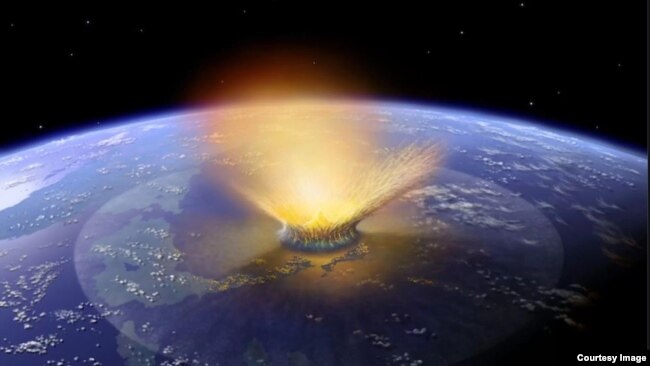恐竜を絶滅させたとされる小惑星の威力。その2番目の小惑星のニュースです。
そして、その恐怖は映画にも幾度となく登場しています。もしこれが現代に起こったら、何を望むのでしょう、となどど思いながら聴きました。
VOAで英語を学びましょう!!
2番目の小惑星が地球に衝突した可能性を科学者が示唆(和訳)
Scientists Say Second Killer Asteroid May Have Struck Earth
August 29,2022
科学者たちは、ほぼすべての恐竜を絶滅させたと考えられている小惑星とほぼ同時期に、2番目の小惑星が地球に衝突した可能性を調査しています。
この調査は、最近海中で発見された小さなクレーターに関連しています。研究者によると、このクレーターは大型の小惑星によって作られた可能性があるとのことです。
科学者たちは、約6600万年前にメキシコのユカタン半島付近に大きな小惑星が地球に衝突したと長い間考えてきました。その衝突の力は、約100億個の核爆弾の強さに等しいと推定されています。
この衝突は、広範囲におよぶ山火事、地震、巨大な海の波、すなわち津波を引き起こしたと考えられています。また、大気中に化学物質が放出され、深刻な冷却を引き起こしたと考えられています。
この気候変動は、植物や動物の70%以上を消滅させたとされています。鳥類以外のすべての恐竜が絶滅したのです。
その衝突によって、幅約180キロメートル、深さ約900メートルの巨大なクレーターができました。
研究者たちは、北大西洋で新たに発見されたクレーターはもっと小さいと言います。幅は約8.5キロメートル。西アフリカのギニア沖の海底から400メートルの深さに埋まっています。
このクレーターは、地震観測機器を使って発見されました。地震計は、地震を測定したり、地球上の他の振動信号を拾ったりするために設計されています。
このクレーターは、スコットランドのエディンバラにあるヘリオットワット大学の地質学者、ユイスディーン・ニコルソン氏によって発見されました。当時ニコルソン氏は、海底の拡がりを利用した海洋地図作成プロジェクトに携わっていました。このような海底拡散は、アフリカ大陸とアメリカ大陸が長い時間をかけて分離し、大西洋の形成につながったものです。
「私はこれまで多くの地震データを解釈してきましたが、このようなものは見たことがありませんでした。」とニコルソン氏は声明の中で述べています。彼は、データが "非常に珍しい特徴を持つ " 巨大なクレーターを記述しているのを見て、驚いたと付け加えています。
ニコルソン氏は、このクレーターは、小惑星によって作られた可能性を示唆するいくつかの要素を持っていると述べています。しかし、彼は、その説を確認する前に、研究者がもっと調査する必要があると指摘しました。チームは、クレーターを訪れて海底を掘り、鉱物のサンプルを採取する予定です。
このチームの発見は、最近出版されたScience Advances誌の研究として報告されました。
ベロニカ・ブレイ氏も研究チームのメンバーで、アリゾナ大学の惑星科学者です。ブレイ氏は、このような衝突がもたらしたであろう影響を予測するために、コンピューター・シミュレーションを使用しました。
そのシミュレートは、クレーターが400メートルの小惑星が500メートルから800メートルの水中に衝突してできたことを示唆しています。また、高さ900メートルの津波や、震度6弱の地震が発生した可能性もあると彼女は言います。
ブレイ氏は、今回発見されたクレーターの影響は、現在のメキシコを襲ったものよりもはるかに小さいと指摘します。しかし、それでも地元の破壊を”著しく”増大させたことでしょう。彼女は、この新しい発見によって、科学者がまだ見つけていない他の衝突クレーターが存在するのではないかと考えていると言います。
ニコルソン氏は、彼のチームが両方の衝突クレーターが関連している可能性を検討したと語ります。研究者たちは、新しく発見されたクレーターは、親となる小惑星の崩壊によって形成された可能性があると考えていると言います。
ショーン・ガリック氏は、テキサス大学オースティン校のクレーター衝突の専門家です。彼はこの発見を”エキサイティング”な発見と呼び、同時期に起こりうる他の衝突のさらなる調査につながる可能性があるとしています。
「40億年もの間、地球に衝突してきたインパクターがあるにもかかわらず、発見されたのはわずか200個にすぎません。」と、ガリック氏は声明の中で述べています。「したがって、新しい衝突の可能性が発見されるたびに、特に調査が困難な(海洋)環境では、エキサイティングなニュースです。」と彼は付け加えました。
Scientists Say Second Killer Asteroid May Have Struck Earth
Scientists are investigating the possibility that a second asteroid hit Earth about the same time as the one believed to have killed off nearly all dinosaur life.
The investigation is linked to a smaller crater recently discovered in the ocean. Researchers say the crater may have been created by a large asteroid.
Scientists have long believed that a large asteroid hit Earth about 66 million years ago near Mexico’s Yucatán Peninsula. They estimate the force of the crash to be equal to the strength of about 10 billion nuclear bombs.
The strike, or impact, is believed to have caused widespread wildfires, earthquakes and huge ocean waves, or tsunamis. Scientists also believe the event caused a release of chemicals into the atmosphere that led to severe cooling.
The climate-changing event is blamed for causing the disappearance of more than 70 percent of plant and animal life. All dinosaurs that were not bird-like died out.
That strike created a huge crater about 180 kilometers wide and 900 meters deep.
Researchers say the newly discovered crater, found in the North Atlantic Ocean, is much smaller. It is about 8.5 kilometers wide. It is buried up to 400 meters below the seabed off the coast of Guinea, in West Africa.
Scientists found the crater by using seismic instruments. Such tools are designed to measure earthquakes and pick up other vibration signals on Earth.
The crater was discovered by Uisdean Nicholson, a geologist at Heriot-Watt University in Edinburgh, Scotland. At the time, Nicholson was working on an ocean-mapping project involving seabed spreading. This kind of spreading is what caused the African and American continents to separate over time, leading to formation of the Atlantic Ocean.
"I've interpreted lots of seismic data in my time, but had never seen anything like this,” Nicholson said in a statement. He added that he was surprised to see that the data described a huge crater “with very unusual characteristics.”
Nicholson said the crater has several elements that suggest it could have been created by an asteroid. But he noted that researchers will need to investigate more before that theory can be confirmed. A team plans to visit the crater to drill into the seabed and collect mineral samples.
The team’s findings were recently reported in a study in the publication Science Advances.
Veronica Bray is another member of the research team. She is a planetary scientist at the University of Arizona. Bray used computer simulations to predict the effects that such an impact would have had.
The simulations suggested the crater was created by a 400-meter asteroid crashing into 500 to 800 meters of water. She said this would have likely caused a 900-meter-high tsunami, as well as an earthquake with a strength of 6.5.
Bray noted the effects of the newly discovered crater would have been much less than the one that hit present day Mexico. But it still would have added “significantly” to local destruction. She said the new discovery makes her wonder whether there are other impact craters that scientists have not yet found.
Nicholson said his team has considered the possibility that both impact craters could be linked. The researchers said they believe the newly discovered crater could have formed by the breakup of a parent asteroid.
Sean Gulick is a crater impact expert at the University of Texas at Austin. He called the find an “exciting” discovery that could lead to further investigations of other possible impacts around the same time period.
“Despite four billion years of impactors hitting Earth, only 200 have been discovered,” Gulick said in a statement. “It is thus exciting news whenever a new potential impact is discovered, especially in the hard-to-explore (ocean) environment,” he added.
Words in This Story
asteroid – n. a rocky object that goes around the sun like a planet
vibration – n. a shaking movement
interpret – v. to explain of explore the meaning of something
characteristic – n. a typical or noticeable quality that makes one person or thing different from others
sample – n. a small amount of something that gives you information about the thing it was taken from
simulation – n. a creation of something that behaves or looks like something real but is not
significant – adj. important or notable
